Overview
States represent the data collection and review stages (e.g. Create, Triage, Review, Investigate, Close, etc.). States allow you to control where an object is created or viewed in an application, required fields that must be completed during certain stages, which state the Object will transition (Triggers) and narrow search results.
A default workflow (Creation, Draft, Active, and Archived states) is automatically added to the Object Type when creating an Object Type. These states can be deleted or supplemented with additional States as needed (except for the Creation state, which cannot be deleted and allows only limited configuration).
User Account Requirements
The user account you use to log into Resolver must have Administrator permission to access Object Types.
Related Setup/Information
See the Edit or Delete a State article for more information on marking fields, properties, or roles as required and changing the State's name or color.
See the Add a Trigger & Transition to a State article for more information on adding triggers, transitions, or actions to a state.
Navigation
- From the Home screen, click on the Administration icon.
![]()
Administration Icon
- From the Admin Overview screen, click on the Configurable Forms tile under the Views section.
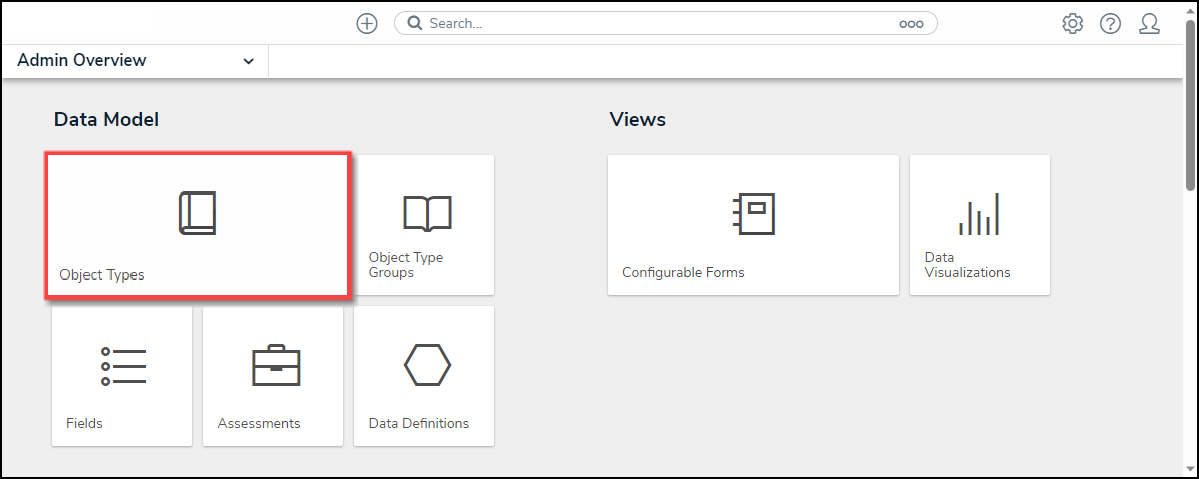
Configurable Forms Tile
Creating a New State
- From the Admin: Object Types screen, enter an Object Type Name in the Search field to narrow the search results list.
- Click on an Object Type Name from the search results lists.
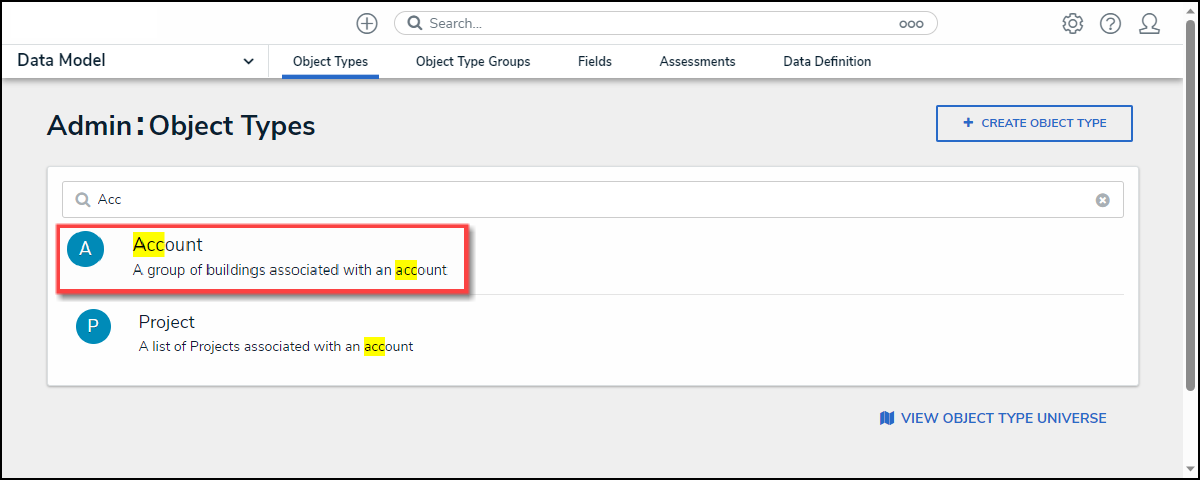
Object Type Name Link
- From the Admin: Edit Object Type screen, click the Configure Workflow button.
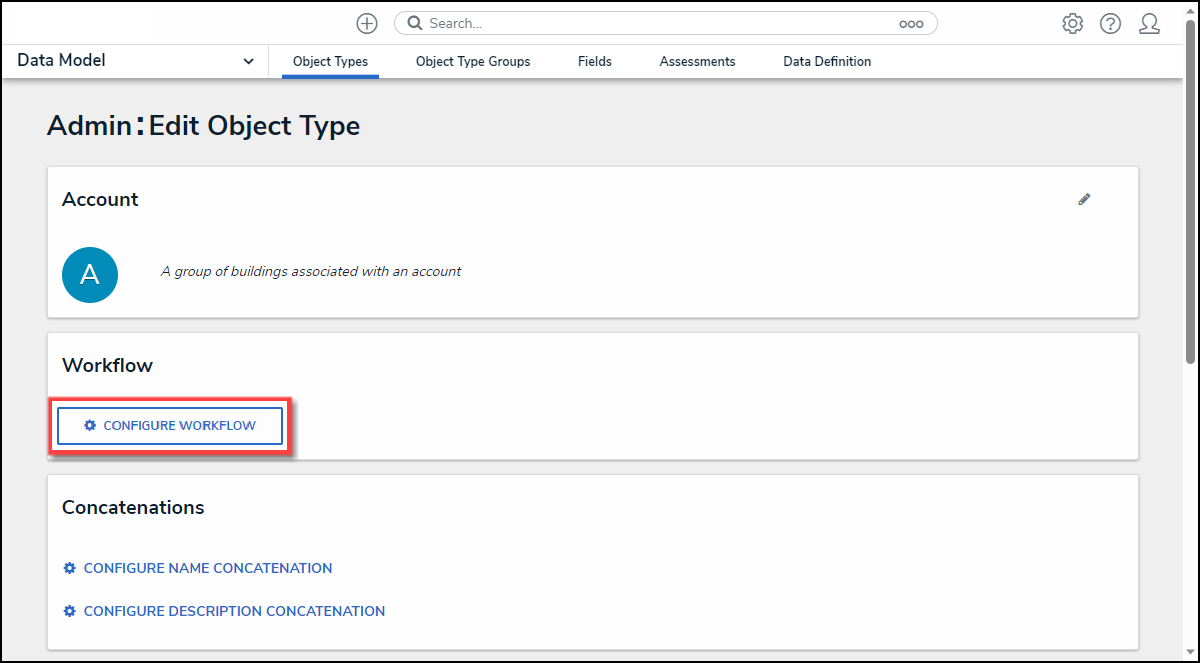
Configure Workflow Button
- From the Admin: Edit Workflow screen, click the + Add State button.

+ Add State Button
- Enter the State's Name in the Name field.
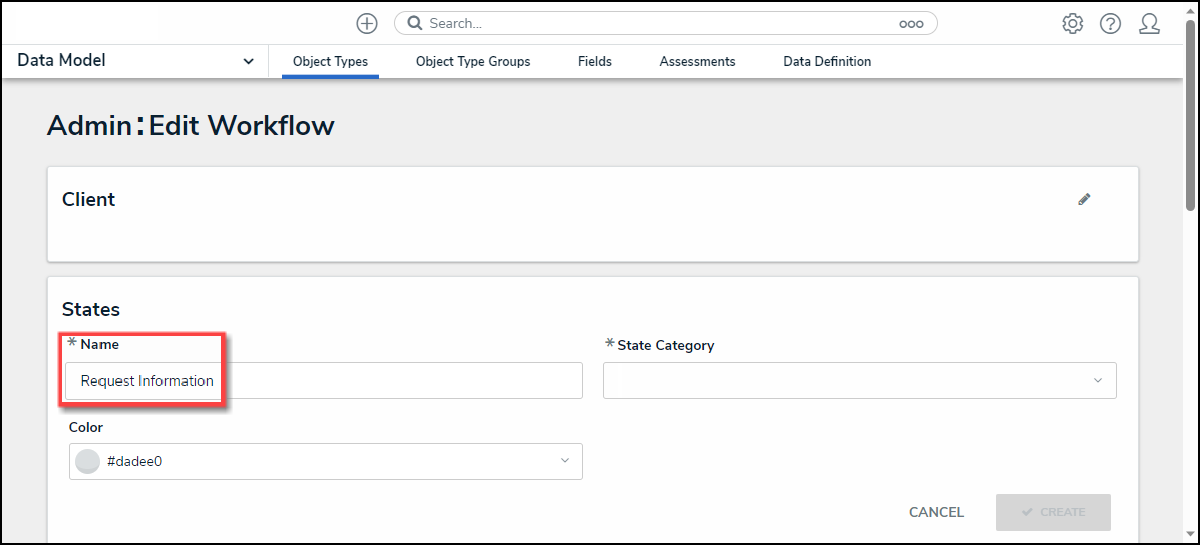
Name Field
- Select a Category from the State Category dropdown menu.
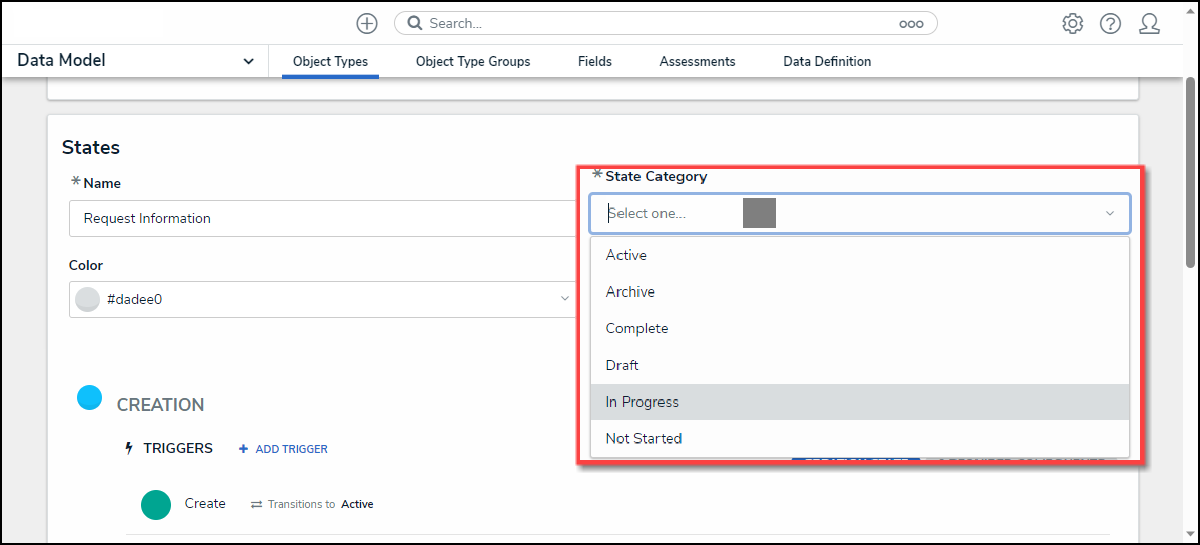
State Category Field
- (Optional) Select a Color Code from the Color dropdown pallet or enter a 6-digit hex color code into the Color field.

Color Field
- Click the Create button to create the new State.

Create Button
- The new State will appear at the bottom of the list on the Admin: Edit Object Type screen.

New State
Overview
Administrator users can edit a workflows name and description.
User Account Requirements
The user must have Administrator permissions in order to access the Admin Overview section.
Navigation
- From the Home screen, click the Administration icon.

Administration Icon
- From the Administrator Settings menu, click Admin Overview.

Administrator Settings Menu
- From the Admin Overview screen, click the Object Types tile under the Data Model section.

Object Types Tile
- From the Admin: Object Types screen, enter a keyword in the Search field to narrow the Object Types list.

Search Field
- Click the Object Type you wish to edit or delete.

Object Type Name
Edit the Workflow Name or Description
- From the Admin: Edit Object Type screen, click the Edit icon.
![]()
Edit Icon
- Click on the Name field and enter a new name value.

Name Field
- Click on the Plural Name field and enter a new plural name value. The plural name will appear when viewing a list of the objects for that type (e.g. “View Incidents” instead of “View Incident”).

Plural Name Field
- Click on the Description field and enter a new description.

Description Field
- Click on the Monogram.

Monogram
- From the Customize Monogram pop-up, enter a new monogram value in the Monogram field.

Customize Monogram Pop-up
- Click the Pick a Color field and select a new color from the Color Picker dropdown menu.

Color Picker Dropdown
- Click the Done button when you are finished.

Done Button
Overview
Timed Triggers automate the Workflow of an object which can transition an object from State to State (e.g., notify users of an overdue date and process imported objects into Workflows). Timed Triggers are scheduled to run at midnight local time.
User Account Requirements
The user account you use to log into Resolver must have Administrator permission to create Timed Triggers.
Related Information/Setup
Please follow the link below for more information on Triggers.
- Creating a Date-Based Trigger
- Orchestration Event Action in Resolver Core
- Add a Create Object Action in Resolver Core
Navigation
- From the Home screen, click on the Administration icon.
![]()
Administration Icon
- From the Admin Overview screen, click on the Object Types tile under the Data Model section.

Dashboard Data Sets Tile
- From the Admin Object Types screen, enter an Object Type Name in the Search field to narrow the search results and click on an Object Type.

Object Type
- From the Edit Object screen, click the Configure Workflow button on the Workflow section.
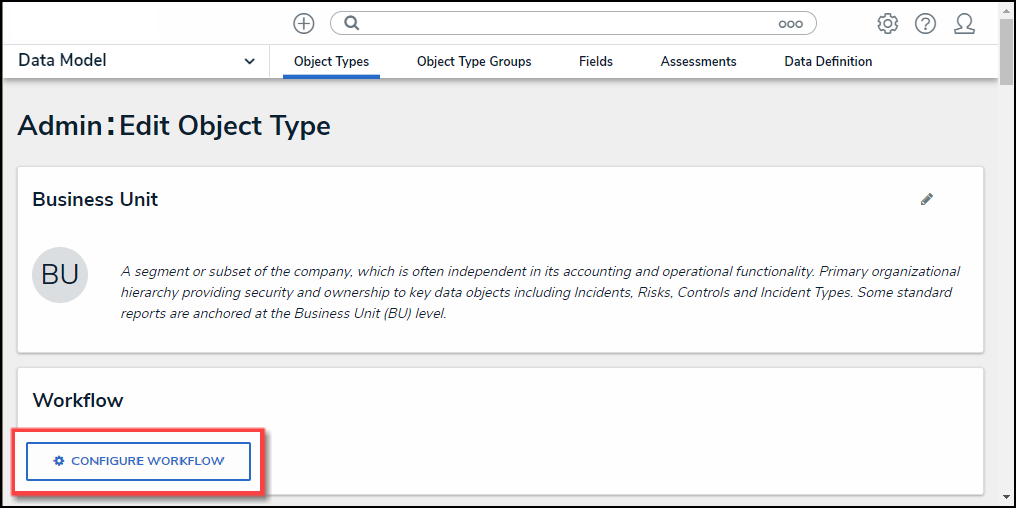
Configure Workflow Button
- If more than one Workflow is set up for the Object Type, click the desired Workflow from the list.

Multiple Workflows
- From the Edit Workflow screen, click the +Add Trigger link under the State you want to add a Trigger.
 Note:
Note:
Timed Trigger cannot be added to a Creation state.
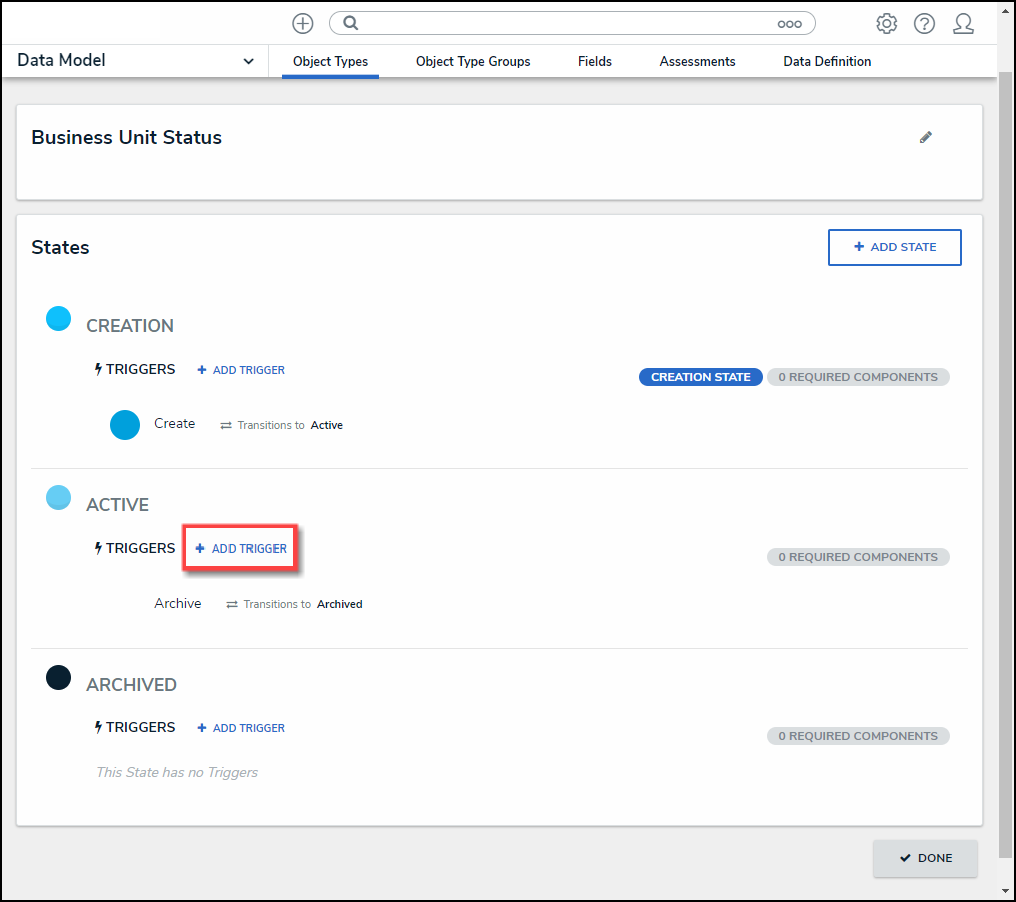
+Add Trigger Link
Adding a Nightly Trigger to a State
- From the Add Triggers pop-up, select Timed from the Type field dropdown menu.

Type Field
- Enter a Trigger Name in the Name field.
- (Optional) Enter a brief description outlining the Nightly Trigger in the Description field.
- (Optional) Select a color from the Color dropdown menu. The Color selected will be applied to the Icon if one is selected.

Color Dropdown
- (Optional) Select an icon from the Icon dropdown menu. The Icon represents the Trigger within the system and appears just before the Trigger Name on the corresponding screens.
![]()
Icon Dropdown
- Select Nightly from the Frequency field dropdown menu.

Frequency Field
- Click the Create button to create the Nightly Trigger.

Create Button
Note:
The Nightly Trigger will appear on the Admin Edit Workflow screen with a Clock icon indicating that the Triggers is a Nightly Trigger.
![]()
Clock Icon
Adding a Transition to a State
- The Edit Trigger pop-up will appear when you click the Create button to create the Trigger.
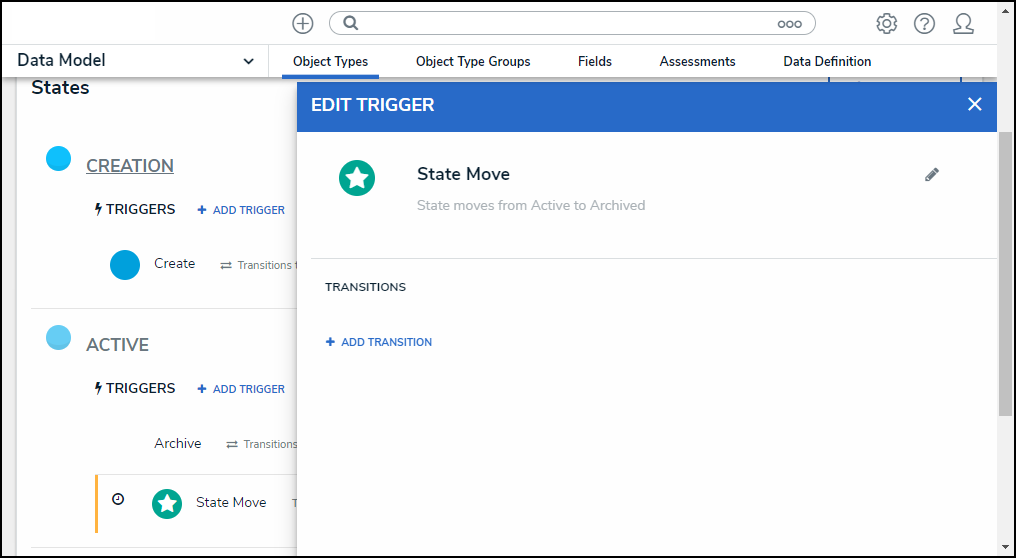
Edit Trigger Pop-up
- Click the +Add Transition link under the Transition section.
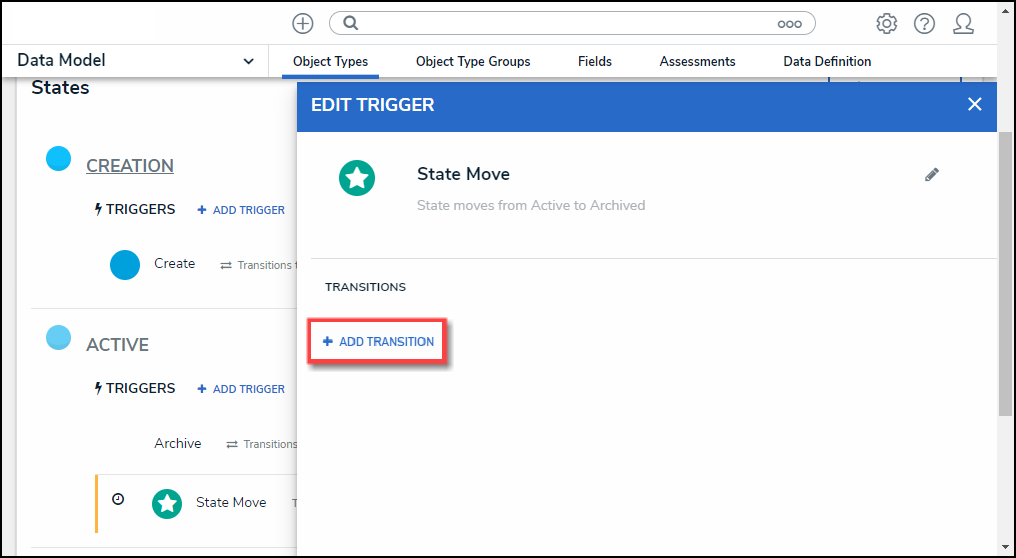
+Add Transition Link
- Enter a Transition name in the Name field.
- Select a state from the Destination State dropdown menu, indicating the State the Object Type will move to when the Transition is executed.

Destination State Dropdown
- (Optional) Select the Bypass Required Fields toggle switch to allow the Transition to move the Object Type to the indicated State if there are empty required fields on the Object Type Form.

Bypass Required Fields
- Click the Create button to create the Transition.

Create Button
Overview
A Condition controls an object's movement to different states or performs a specific action. A Condition consists of fields, formulas, and workflow states that create a formula. The formula uses a set of parameters to control whether a transition or action can occur.
Related Information/Setup
For more information on formulas, see the following articles:
Before adding a Condition to a Transition, you must create a State and a Trigger. See the following articles for more information on creating States and Triggers.
Example
The following example outlines an everyday scenario where you would want to add a condition to a transition.
Your company's policy for severe incidents is to skip the typical review process and transition to the investigation stage. Create a Condition on the Incident object type workflow for the Submit for Review trigger. If the “Severe” option is selected. The object is automatically transitioned to the Investigation Required state once the Submit for Review trigger is selected on a form.
Navigation
- From the Home screen, click the Administration icon.
![]()
Administration Icon
- From the Administration Settings menu, click the Admin: Overview link.

Admin: Overview Link
- From the Admin Overview screen, click the Object Types tile on the Data Models section.
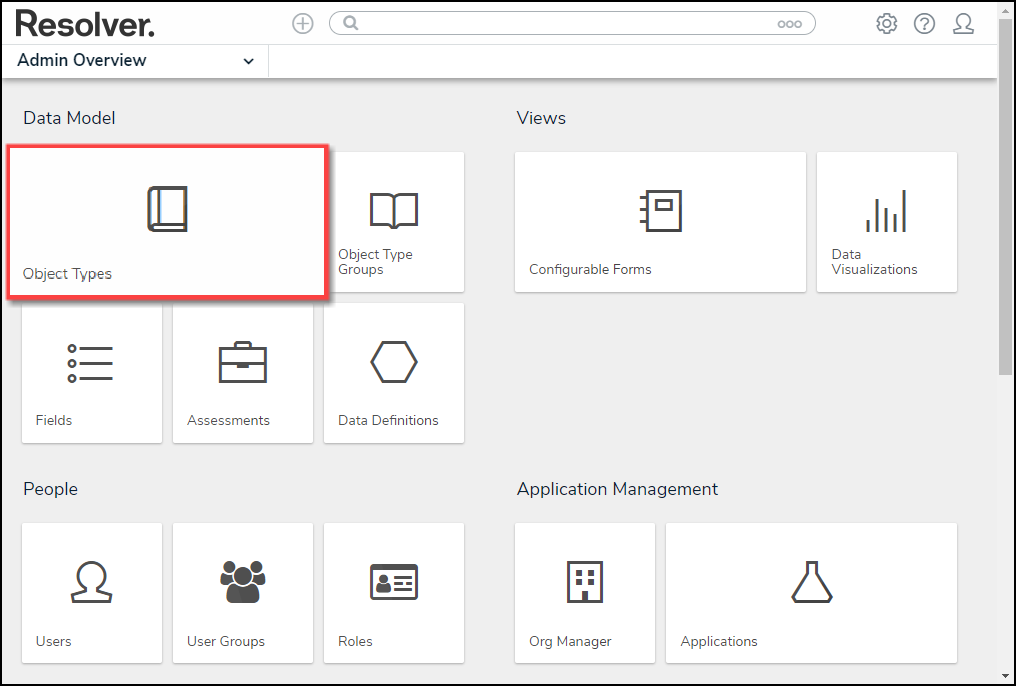
Object Types Tile
- From the Object Types screen, enter an Object Type Name in the Search field to narrow down the list.
- Click the Object Type's Name you want to edit.

Click the Object Type's Name
- From the Edit Object Type screen, click on a workflow under the Workflow section.

Click on a Workflow
- If there are no workflows listed, click on the Configure Workflow button.

Configure Workflow Button
- From the Edit Workflow screen, click a Trigger under the State section.
 Note:
Note:
You must already have a Trigger added to a State before you can add a condition to a transition.

Click on a Trigger
- From the Edit Trigger pop-up, click the Edit icon next to the transition.

Click the Edit Icon
Adding a Condition on a Transition
-
From the Condition section, click the +Add Condition button.

+ Add Conditions Button
- (Optional) Enter a condition name in the Name field under the Details section. By default, conditions are named Default Condition Formula.

Name Field
- (Optional) Enter a brief condition description in the Description field.

Description Field
- From the Variables section, click the +Add Variable button.

+Add Variable Button
- From the Variables section, select a Variable Type from the drop-down list. A Variable is a value in which the formula calculations are performed.
- Field: After selecting the Field variable, the following field will appear:
- Available Components: Select a field or formula from the Available Components drop-down field adding it directly to the Object Type.
 Note:
Note:
Fields must be added to a formula after an Object Type or through an association (Relationship or Reference).
Only numeric fields, date fields, and select lists (numeric values) are accepted. For more information, see the Fields article.

Variable Type = Field
- Relationship: After selecting the Relationship variable, the following fields will appear:
- Relationship: Select the Object Type Relationship from the drop-down list. Relationships connect two or more objects. Relationships must be added to an Object Type to appear on the Relationship drop-down list. See the Add Relationships to an Object Type article for further information on adding a Relationship to an Object Type.
- Available Components: Select a field or formula from the Available Components drop-down field adding it directly to the Object Type.
- Sub Type: Select a Sub Type from the drop-down list. Subtypes specify how the data from multiple objects are compiled, calculated, and displayed. For more information on Subtypes, see the Sub Type Table in the Variables, Operations, & Functions article.
- Array: Creates a set of values from the variable.
- Sum: Calculates a total from the variable's set of values and returns a single number. Select list variables cannot use Sum Sub Types.
- Count: The number of times a variable has been added to an object.
- Average: Calculates an average number from the variable's set of values. Select list variables cannot use Average Sub Types.
- Every: Checks if the variable contains a value on the objects in the relationship/reference.
- Min: Calculates the lowest number from the variable's set of values. Select list variables cannot use Min Sub Types.
- Max: Calculates the highest number from the variable's set of values. Select list variables cannot use Max Sub Types.

Variable Type = Relationship
- Reference: After selecting the Reference variable, the following fields will appear:
- Reference: Select the Object Type Reference from the drop-down list. References indicate that an object is connected to another object through a relationship. References are automatically created when a relationship is created. For further information on adding a Relationship to an Object Type, see the Add References to an Object Type article.
- Available Components: Select a field or formula from the Available Components drop-down field adding it directly to the Object Type.
- Sub Type: Select a Sub Type from the drop-down list. Subtypes specify how the data from multiple objects are compiled, calculated, and displayed.

Variable Type = Reference
- Property: After selecting the Property variable, the following field will appear:
- Property: Select a Property type from the drop-down list:
- Is Submitter Confidential: This property type creates a formula that compares the number of confidential submissions against the number of not confidential submissions for customers that use the Confidential Reporting Portal.
- Property: Select a Property type from the drop-down list:

Variable Type = Property
- The system will automatically populate the Name field with the field or formula's unique ID by default.
- (Optional) Enter a Variable name in the Name field.
 Warning:
Warning:
Using a function name (Sub Type Name) in the name field will cause an error.

Variable Name
- (Optional) Enter a Variable description in the Description field.

Description Field
- (Optional) Select the Treat empty values as Null checkbox, to exclude blank objects from a formula calculation. For more information, see the Null Values in Formulas article.

Treat Empty Value as Null Checkbox
- Click the Create button to add the variable.

Create Button
- Repeat steps 7 - 16 to add additional variables.
- Click the x icon next to the variable to delete the variable.
![]()
X Icon - Delete a Variable
- (Optional) Click the Insert Variable button and select a variable from the dropdown list to use within the Formula field.

Insert Variable Button
- From the Formula section, enter a Formula using the variable name(s) you entered in the Name field under the Variables section. Include operators and functions in the Formula field (e.g., INCIDENTSE==3). For more information on Operators, see the Operators Table in the Variables, Operators, & Functions article.
- A system notification will appear under the Formula field, indicating that Your formula is not saved.

System Notification - Your Formula is Not Saved
- Click on the Save Formula button. The system will perform a Syntax Validation on the formula if the formula is:
- Valid: A system notification will appear under the Formula field; Formula syntax is correct. Formula saved.

System Notification - Valid Formula
- Invalid: A system notification will appear under the Formula field; Error Syntax error in part (char 1). The formula is not saved. The error will indicate the character (char) location of the error in the formula and that the formula is invalid and not saved.

System Notification - Invalid Formula
- Syntax Validation helps to prevent users from saving invalid formula expressions, which can negatively impact APIs.
- Click the Done button to add the Variables to the Object Type.